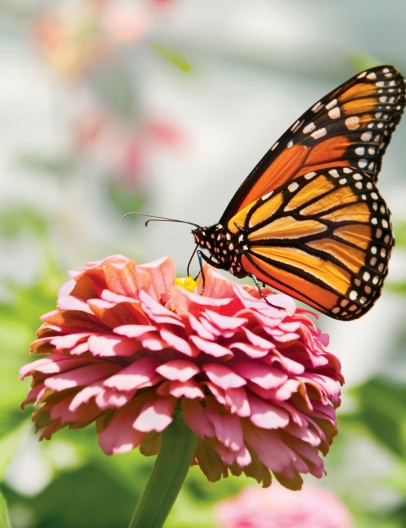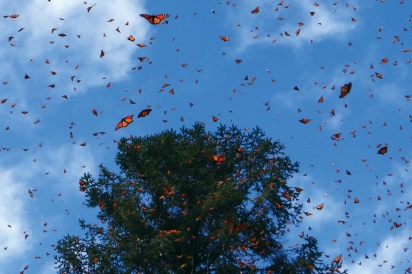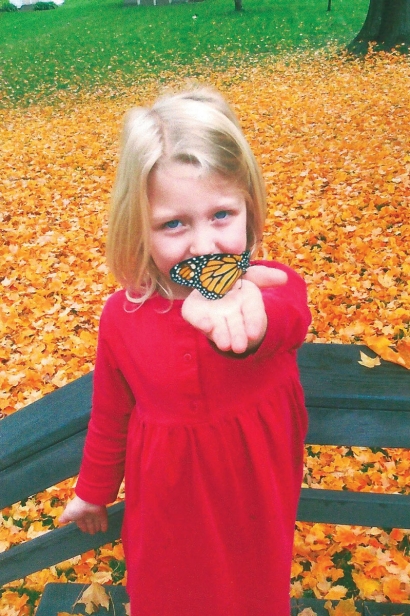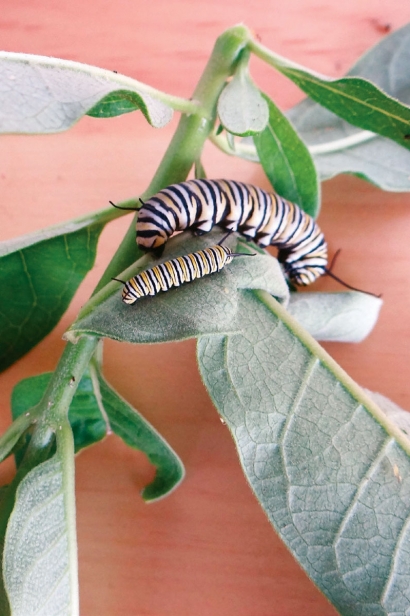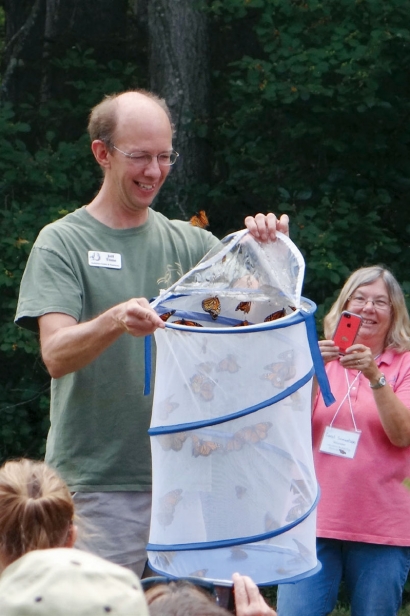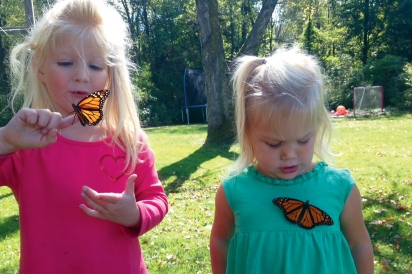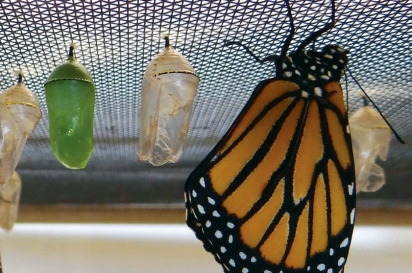Monarch Butterflies, Our Environmental Ambassadors
Protecting the monarch's seat at our table
We went to the movies. . .
We're often asked how we became interested in monarch butterflies. Quite simply, we went to the movies. Not the usual date night mystery or romantic comedy, but an IMAX production at Pittsburgh's Carnegie Science Center of Flight of the Butterflies. In stunning (and dizzying) images, the film recounts the story of the monarchs' perilous and remarkable 2,500-mile migration to Mexico, and the Canadian scientist, Dr. Fred Urquhart, who devoted 40 years to studying and proving the migration's existence. We left the theater moved and decidedly hooked.
Really hooked. Like two eager undergrads, we hit the books–and the internet–and were quickly consumed by all things monarch. Adding to our research resources were scores of articles now popping up in gardening magazines and environmental periodicals. The facts were fascinating, our curiosity was piqued.
This delicate backyard visitor is really a tower of strength. While weighing less than a paperclip, monarchs are capable of flying 12–25 miles per hour and 50–100 miles per day on their journey to Mexico. Female monarchs can lay as many as 300 eggs, but only one at a time, spreading them out over hundreds of milkweed plants. This ensures adequate food for the emerging larva, who increase their body weight an incredible 3,000 times in just 10–14 days. They consume so much so quickly, they need to shed their skin five times.
Of particular interest to us is the fact that monarch butterflies emerging from their chrysalises in late August and early September here in WNY (and across the northern U.S. and southern Canada) are actually the great-great-grandchildren of the monarchs who wintered in Mexico. They are known as the Methuselah or super generation. Unlike the three generations before them which live six to eight weeks (it takes three generations to make the northern migration), they suspend their reproductive function and live six to eight months in order to make the migration all the way back to Mexico. Yet these impressive facts are all tempered by a sobering reality.
The iconic monarch and its migration, once a familiar sight throughout much of North America, is now threatened. Over the past 20 years, the monarch population has dropped nearly 90 percent due to massive loss of habitat, expanded use of insecticides and herbicides and the impacts of climate change.
Given the uncertain future of this migratory wonder, we decided to travel to Mexico to see first-hand the migration site. All of the migrating monarchs east of the Rockies find their way to the same small area, their ancestral wintering grounds in the remote Sierra Madre Mountains northwest of Mexico City.
The Monarch Butterfly Biosphere Reserve was established in 1986 by the Mexican government and designated a UNESCO World Heritage Site in 2008. Created to protect the winter habitat and to study the species, the reserve now includes roughly 56,000 hectares, although the butterflies actually inhabit a much smaller area.
Our trek took us to the state of Michoacán and the El Rosario sanctuary. Our guide was able to drive well up the mountain to a trailhead at almost 10,000 feet. From there, a one-mile hike climbed another 1,000 feet to a grove of giant oyamel fir trees, whose branches were nearly unrecognizable under the tens of thousands of monarchs clustered there.
As we stood in what can only be described as reverent silence, the sun briefly broke through the mountaintop clouds and an explosion of orange and black took to the sky, the monarchs awakened from their rest by the sudden warmth. In that fleeting moment, the beating of a hundred thousand wings was audible.
Illegal logging in these Mexican reserves continues to be one of the major causes of habitat loss. Efforts by the Mexican government and the volunteer "patrols" of local villagers have reduced but not eliminated the activity.
But the greatest cause of habitat loss has been continued urban/ suburban sprawl and commercial land development combined with changes in U.S. agriculture, particularly the rapid expansion of corn and soy production.
Driven largely by market demand resulting from the use of ethanol in gasoline, it is estimated that over 15,000,000 acres of corn have been added over the past 20 years. Newly developed genetically modified crop seeds and plants are resistant to the effects of herbicides, allowing for broader applications that kill surrounding wildflowers and nectar plants, a critical source of food for adult monarchs and other pollinators.
Also eliminated are milkweed plants, the only host plant for monarch larva. Because of the multigenerational nature of the monarch's migration, any significant reduction or disruption of habitat along the migration path impacts the health and vitality of each subsequent generation.
Ninety percent of corn and canola seed (and nearly half of the soybean seed) is treated with the most widely used class of insecticides called "neonicotinoids" or "neonics." Neonics are systemic: Absorbed into the plant tissue, they send toxins from the roots to the nectar upon which butterflies and bees feed.
The recent collapse of nearly half of America's honeybee colonies may have multiple causes, including disease, loss of habitat and climate change, but exposure to neonics is increasingly implicated. Effects of the insecticides can include lowered resistance to disease, disorientation and disruption in feeding habits, reproductive abnormalities and increased susceptibility to winterkill.
Many popular seed catalogs now list seeds that are "neonicotinoid-free," and on January 1, 2018, Maryland will become the first state to limit the allowed applications of the insecticides. Bees and butterflies account for the pollination of 70 percent of our fruit and vegetable crops–not to mention an abundance of flowers–making their welfare and sustainability essential to human health and well-being.
The more erratic weather patterns associated with climate change also take their toll. An unprecedented winter storm in the Mexican overwintering sites in March 2016 killed nearly 50 percent of the monarch population. This winter, the warmest on record in Mexico (and the warmest on record globally, according to the National Oceanic and Atmospheric Agency), caused the monarchs to be more active and thus to use more of the fat stores and energy required to begin their journey north. Extended droughts, floods and dramatic temperature swings also affect the emergence and availability of milkweed and nectar plants upon which migrating monarchs depend.
In the face of these threats, the monarch has emerged as a "flagship species," emblematic of broader environmental issues–habitat loss, GMOs, herbicide and pesticide use, climate change–and offers insights and opportunities to address them. What is good for the monarch is ultimately good for other essential pollinators–and, by extension, beneficial to birds and animals–and contributes to a biologically diverse and healthy environment.
The beauty and familiarity of the monarch makes it easy for both children and adults to relate to these issues and reconnect to the natural world. While many environmental causes may seem too complex, or too geographically distant, or the solutions too improbable, the monarch cause can be taken up successfully in any community: by individuals, groups or institutions, by young and by old.
On the local level, gardeners can plant milkweed and nectar plants, schools can initiate monarch projects (see sidebar), farmers can return selected plots of land to native plants, "citizen scientists" can record and report essential monarch data, highway departments can time their roadside mowing to enhance habitat and protect monarch breeding grounds, and parks departments and golf courses can create or expand "no-mow zones."
Here in WNY, we not only provide a breeding ground for the super generation but also bear a responsibility for the provision of nectar plants, supplying the food and energy necessary for the long migratory journey. Monarchs heading south from lower Ontario can sometimes be observed in clusters along our Lake Erie shoreline during late summer and early autumn, resting and feeding before continuing the migration to Mexico.
On the national level, a remarkable organizational partnership has been created: the Monarch Joint Venture. Over 50 federal and state agencies, nongovernmental nonprofits and educational institutions are working cooperatively to protect monarchs and their migration, bringing diverse capabilities, resources, and perspectives to the task. Never has such a small creature marshaled such a formidable alliance.
We recently came upon an image of a monarch in Texas. The butterfly had survived the horrendous winter storm in the spring of 2016 and flown 700 miles from Mexico to breed and begin the next generation. Its beautiful wings were torn and battered. We've titled it simply, "Resilience." If this remarkable natural wonder can show that much strength and courage, the least we all can do is try to help.
BRING BACK THE MONARCH PROJECT
Initiated by the Voelkers in 2016, the "Bring Back the Monarchs" project at Chautauqua Lake Central School in Mayville, NY presents a series of monarch related activities to fourth and fifth graders.
Classroom sessions, growing and planting milkweed and nectar plants, and raising and releasing monarchs provide year-long engagement that not only shares the monarch's story, but also introduces broader environmental issues.
The school's new butterfly garden has been certified as a "Monarch Waystation," part of the Monarch Watch program initiated by the University of Kansas (there are now over 100 waystations across WNY and NW Pennsylvania, and nearly 16,000 nationwide). And this year, the project led to an innovative high school field science elective titled "Metamorphosis: A Course About Change."
With the enthusiasm and commitment of the teachers, administration and staff, the "Bring Back the Monarchs" project continues to offer young students practical hands-on lessons in environmental stewardship.


